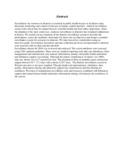| dc.description.abstract | Surveillance for zoonoses in abattoirs is essential in public health because it facilitates early detection,
monitoring and control of diseases at human- animal interface. Abattoir surveillance can provide
critical data for animal diseases of public health and food safety importance. Since the adoption of the
meat control act, zoonoses surveillance in abattoirs has remained rudimentary in Kenya. We carried
out an evaluation of the abattoir surveillance system to describe the performance, assess the attributes,
determine if it meets the set objectives and design a standard surveillance system for zoonoses in
abattoirs. We interviewed key stakeholders using an interview guide. Surveillance documents and
data collection processes at representative abattoirs were assessed with an observational checklist.
Surveillance dataset for 2010 was reviewed and analyzed. The system attributes were assessed
using CDC updated guidelines. There were no standard reporting tools and case definitions. Data
management and transmission were manual. Information sharing with public health authorities and
laboratory support was lacking. Although the annual completeness of reports was 100%, only one
district out of 27 reported on time .The duration of delay in monthly report submission ranged between
18.7- 37.3 days with a mean of 28.7 days . The abattoir surveillance system in Western province is
not up to standard. Though simple and representative, timeliness, data quality, information sharing
and laboratory support are unsatisfactory thereby limiting its usefulness. Provision of standardized
surveillance tools and resources combined with laboratory support and animal-human health authorities
information sharing will enhance the usefulness of the system. | en_US |

